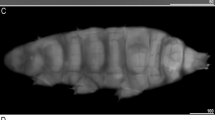Abstract
THE tarsal organ of deer of the genus Odocoileus is located, medially on the ankle (Fig. 1) and consists of sebaceous and apocrine sudoriferous glands as well as greatly enlarged arrector pili smooth muscle bundles1, which effect the erection of a long tuft of bright, stiff hairs. The hairs in the centre of the tuft are covered with a lipid film carrying the scent. The glands and urine are the possible sources of the tarsal scent. Tarsal organs are found only in tele-metacarpal deer (Odocoileinae); that is, in the New World genera Odocoileus, Blastocerus and Mazama, and in the Holarctic genera Alces and Rangifer2.
This is a preview of subscription content, access via your institution
Access options
Subscribe to this journal
Receive 51 print issues and online access
$199.00 per year
only $3.90 per issue
Buy this article
- Purchase on Springer Link
- Instant access to full article PDF
Prices may be subject to local taxes which are calculated during checkout
Similar content being viewed by others
References
Quay, W. B., J. Mammal., 40, 114 (1959).
Schaffer, J., Die Hautdrusenorgane der Saugetiere, 367 (Urban and Schwarzenberg, Berlin and Vienna, 1940).
Muller-Schwarze, D., Amer. Zool., 7, 430 (1967).
Beroza, M., and Sarmiento, R., Anal. Chem., 35, 1353 (1963).
Brownlee, R. G., and Silverstein, R. M., Anal. Chem., 40, 2077 (1968).
Beroza, M., and Bierl, B. A., Anal. Chem., 39, 1131 (1967).
Van Der Zijden, A. S. M., Rev. Franc. Corps Gras, 13 (12), 713 (1966); C. A., 65, 12, 778h.
Silverstein, R. M., Rodin, J. O., and Wood, D. L., Science, 154, 509 (1966).
Wood, D. L., Stark, R. W., Silverstein, R. M., and Rodin, J. O., Nature, 215, 206 (1967).
Silverstein, R. M., Brownlee, R. G., Bellas, T. E., Wood, D. L., and Browne, L. E., Science, 159, 889 (1968).
Wood, D. L., Browne, L. E., Bedard, W. D., Tilden, P. E., Silverstein, R. M., and Rodin, J. O., Science, 159, 1373 (1968).
Author information
Authors and Affiliations
Rights and permissions
About this article
Cite this article
BROWNLEE, R., SILVERSTEIN, R., MÜLLER-SCHWARZE, D. et al. Isolation, Identification and Function of the Chief Component of the Male Tarsal Scent in Black-tailed Deer. Nature 221, 284–285 (1969). https://doi.org/10.1038/221284a0
Received:
Issue Date:
DOI: https://doi.org/10.1038/221284a0
This article is cited by
-
Cervidins A-D: Novel Glycine Conjugated Fatty Acids from the Tarsal Gland of Male Whitetail Deer, Odocoileus virginianus
Journal of Chemical Ecology (2021)
-
Are mammal olfactory signals hiding right under our noses?
Naturwissenschaften (2013)
-
Host Specific Cephenemyia of Deer Repelled by Non-Host Odors
Journal of Insect Behavior (2012)
-
The Chafer Pheromone Buibuilactone and Ant Pyrazines are also Produced by Marine Bacteria
Journal of Chemical Ecology (2005)
-
Analysis of chemical signals in a primate species (Saguinus fuscicollis): Use of behavioral, chemical, and pattern recognition methods
Journal of Chemical Ecology (1986)
Comments
By submitting a comment you agree to abide by our Terms and Community Guidelines. If you find something abusive or that does not comply with our terms or guidelines please flag it as inappropriate.



